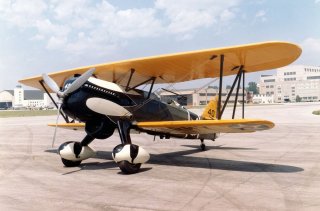Curtiss P-6 Hawk: The Deadly Fighter That Never Fired a Shot
Introduced in 1927 it was a cutting-edge aircraft that remained in operation until the late 1930s, yet never saw service in any armed conflict.
Had the Great Depression not put a strain on the U.S. Army Air Corps' budget, it is likely that greater numbers of the Curtiss P-6 would have been produced as it proved to be an agile aircraft, but cost-cutting was its greatest foe.
Introduced in 1927 it was a cutting-edge aircraft that remained in operation until the late 1930s, yet never saw service in any armed conflict.
With its clean, almost art deco-inspired lines, the Curtiss aircraft has been described as one of the "most beautiful biplanes ever built," but it was also a fast and highly maneuverable fighter for its time that led to future aviation innovation, which led to such aircraft as the P-40 Warhawk.
It was also among the most notable of aircraft in the series of Curtiss-produced fighters carrying the name "Hawk," which began with the P-1 in 1925. The P-6 proved to be the pinnacle of the series. The XP-6A prototype, which Curtiss developed in the mid-1920s, went on to take first place at the 1927 U.S National Air Races while the XP-6 model took second place. The winning aircraft, which had surface radiators reached an impressive speed of 201 mph.
More Than One P-6
Several models of the P-6 were produced – and a total of seventy of the aircraft in various configurations were built at a reported cost of $13,000, which was a considerable amount of money at the time. In fact, the high cost was what contributed to the limited production.
Of the various models, the P-6E remains the most well-known of the eight variants produced. It was originally designated the Y1P-22, but the Army Air Corps redesigned the P-6E because of its similarity to the other models. A total of forty-six were produced and it became the last biplane fighter built for the Army Air Corps.
A heavily modified P-6E, which featured a supercharged Conqueror engine and was flown by U.S. Army Air Corps Capt. Ruben C. Moffat in his 1932 record-breaking flight from Dayton, Ohio to Washington, D.C. at a speed of 266 mph and an altitude of 25,000 feet.
Despite never firing its guns in anger, the P-6E was well armed for the time with two .30 caliber machine guns. The aircraft was powered by a Curtiss V-1570 engine, which provided 600 hp. It had a maximum speed (unaltered) of 204 mph and a cruising speed of 167 mph with a range of 480 miles. The open cockpit aircraft had a ceiling of 24,400 feet.
Today, of the forty-six produced, only a single original P-6E remains in existence. It appears in the colors and markings of the airplane that was assigned to Capt. Ross G. Hoyt, commanding officer of the 17th Pursuit Squadron, 1st Pursuit Group, which was based at Selfridge Field, Michigan in 1933.
The aircraft had been sold as surplus by the military and was donated to the museum. It was painstakingly restored to its current condition by the Department of Aviation Technology at Purdue in 1963.
Peter Suciu is a Michigan-based writer who has contributed to more than four dozen magazines, newspapers and websites. He is the author of several books on military headgear including A Gallery of Military Headdress, which is available on Amazon.com.

